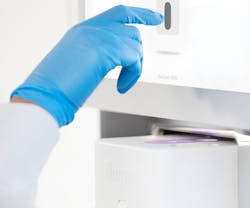Photonics plays key role in the DNA sequencing revolution
DNA sequencing will soon be ready to take the leap from laboratory research to actual clinical applications such as testing for cancer and other genetic diseases.
“That transition is a major theme for the future of DNA sequencing,” says Stanley Hong, vice president, distinguished engineer, and head of optical systems at Illumina (San Diego, CA), an international biotechnology research company. They develop and test DNA and genetic sequencing techniques and technologies, which are rapidly moving toward the clinical applications realm (see Fig. 1).
The company was founded during the Human Genome Project—an international collaborative research program led by the U.S. National Academy of Sciences that ran from the late 1980s to the early 2000s. The project focused on determining the order of the four chemical building blocks—called bases—that form a DNA molecule. There are about three billion base pairs that essentially make up and support humans.
Sequencing provides the genetic information carried in a particular DNA segment, Hong says. That data can determine what DNA stretches contain genes and which stretches can regulate those genes, turning them on or off. Data obtained can also show changes in a gene that could cause disease.
From this, the goal of the Human Genome Project was to complete the full mapping and understanding of all the genes (including DNA, RNA, and proteins) in human beings. A team of international researchers met about 90% of that goal by 2000, reaching it in full just a couple of years later. This spurred biologists and biotechnology experts to continue advancing that work.
The role of photonic technology
Photonics and optics technologies have been central to DNA and genetic sequencing, Hong says, citing high-speed, high-resolution fluorescence imaging used to study the clusters of flow cells. Illumina’s sequencing by synthesis (SBS) technology and its SBS chemistry use that technique.
This involves a fluorescently labeled reversible terminator that’s imaged as each of the four individual dNTPs—deoxynucleoside triphosphate, the synthesis and destruction of which regulate the replication of both cell and virus genomes—are added. These are then divided to allow incorporation of the next base. Those four reversible terminator-bound dNTPs are present during each sequencing cycle, allowing natural competition to minimize any incorporation bias as well as producing highly accurate data.
SBS has been adopted worldwide for next-generation sequencing. In fact, it generates more than 90% of the world’s DNA/genetic sequencing data. It helps make what the company calls “massively parallel sequencing” more effective, thanks to a technique that can detect single bases as they’re being incorporated into growing DNA strands.
Illumina’s sequencing technologies have expanded beyond just serving simply as products—they’ve become actual standard components of many systems and technologies used by biologists and biotechnologists. Hong says researchers can sequence six gigabases in a 44-hour run (equaling 3.3 billion bases per day) and a single flow cell, part of the company’s NovaSeq technology, can now contain up to 10 billion clusters.
The components use LEDs, laser diodes, and DPSS lasers for fluorescence excitation in blue, green, and red wavelengths, he says, and detection in DNA sequencing can be accomplished with CCD and CMOS image sensors.
Illumina’s work continues, Hong says, with researching the expanded use of high-power, low-cost light sources, as well as techniques such as broadband imaging with high numerical aperture and wide field of view, super-resolution imaging, line-scan imaging, and disposable CMOS image sensors.
Microfluidic systems—specifically digital microfluidics—are another sequencing tool. Developed by Illumina, digital microfluidics is a fluid-handling technique that can precisely manipulate nanoliter-sized droplets. This eliminates most manual steps during procedures such as sequencing library preparation, quantification, and normalization. The technique is based on electrowetting, which allows researchers to control droplets. Aqueous droplets naturally bead up on a hydrophobic surface, but those droplets can spread across the surface when voltage is applied between them and an insulated electrode.
DNA sequencing’s purpose
While the foundational use of sequencing is understanding humans’ genetic makeup and DNA, it plays a major role in studying and understanding genetic diseases.
“Major clinical applications for DNA sequencing include genetic disease testing and reproductive health,” Hong says.
Oncology is another area in which DNA sequencing is a key tool.
“Cancer, in the end, is cells that start dividing uncontrollably because they’re a kind of genetic mutation,” says Pol Van Dorpe, a professor at Katholieke Universiteit Leuven (Belgium), and a Fellow and researcher at imec, an R&D innovation center whose research domains include DNA sequencing in the bio and life sciences sectors. Illumina’s techniques and technologies have been key to his and others’ sequencing work (see Fig. 2). “Cancer is actually a genetic disease because it’s the cancer cells’ genes that are responsible.”Sequencing allows researchers to better analyze the free-circulating DNA in the blood, not only for cancer detection but other genetic diseases, he says, including cystic fibrosis and Huntington’s disease, and “you can look at mutations and even identify which are rare, so you start determining how to deal with it.” Van Dorpe adds that liquid biopsies—the sampling and analysis of non-solid biological tissue, specifically blood—could ultimately become a more common part of the process.
“DNA sequencing is also catalyzing growth in drug discovery, where genomic-based methods can dramatically improve speed to market, success rates, and cost,” Hong says. “And it has had a major impact during the pandemic by enabling COVID tracking and global surveillance of novel variants. In the future, sequencing technology will expand into pan-pathogen genomic epidemiology.”
According to Van Dorpe, vaccines for COVID were developed so quickly after the pandemic began because advances in DNA sequencing allowed scientists to quickly discover the virus.
Advanced imaging technologies have enabled the capabilities of DNA sequencers today. “Further innovations that push the limits of resolution, sensitivity, and throughput will power the genomics capabilities needed for the next decade,” says Hong.
About the Author
Justine Murphy
Multimedia Director, Digital Infrastructure
Justine Murphy is the multimedia director for Endeavor Business Media's Digital Infrastructure Group. She is a multiple award-winning writer and editor with more 20 years of experience in newspaper publishing as well as public relations, marketing, and communications. For nearly 10 years, she has covered all facets of the optics and photonics industry as an editor, writer, web news anchor, and podcast host for an internationally reaching magazine publishing company. Her work has earned accolades from the New England Press Association as well as the SIIA/Jesse H. Neal Awards. She received a B.A. from the Massachusetts College of Liberal Arts.


